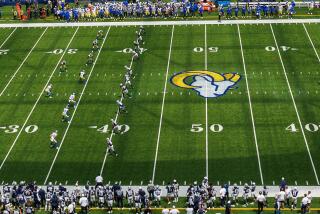Hockey still plagued by concussions, despite rule changes

- Share via
Fighting and body-checking are as integral to ice hockey as skates and pucks, but at what cost? A new study published in the journal PLOS One reveals that despite the National Hockey League’s recent ban on hits to the head, concussions during games have actually increased.
Along with football, ice hockey has come under fire for having a high incidence of concussions. In an effort to curb these traumatic brain injuries, the NHL banned blindside checks to the head in its Rule 48 before the 2010-11 season. The following season, the rule was expanded to ban all hits to the head.
Dr. Michael Cusimano, a neurosurgeon at the University of Toronto’s St. Michael’s Hospital and a lifelong hockey fan, was hoping the rule would reduce the number of concussions.
“I see my job as more than just mopping up after people get hurt,” Cusimano said. “I think we have a social responsibility to look at ways to prevent the condition that we’re treating.”
For the study, Cusimano and his colleagues surveyed NHL games from three seasons — one before Rule 48 and two that came after — to measure its effect. Since team medical records were not available, they relied entirely on publicly available documentation of injury, including official team injury reports, team websites and news articles. They counted the number of concussions and suspected concussions in both the NHL and the Ontario Hockey League, a junior hockey division that served as a control because it banned hits to the head in 2006.
Cusimano’s group also examined a subset of games in detail, providing one of the most plum internships imaginable for an undergrad. Their job? Watch every game in a 10-week span to identify the cause of each concussion and suspected concussion. They also recorded every penalty to see how often they were linked to concussions.
The results were disheartening.
The year the rule change went into effect, concussions in the NHL jumped from 44 to 65, a statistically significant increase. The number went up again in Year 3, to 85, but that increase was not statistically significant. Concussion incidence was similar in the OHL, but showed almost no significant differences year to year.
Perhaps more surprisingly, most concussions were linked to legal hits or nonpenalized plays.
“In only 28% of the concussive events was there a penalty issued,” Cusimano said.
The most common cause of concussion in the NHL was body-checking, at 64.2%. And many of those hits were not directed at the head, underscoring the real problem: Perfectly legal, even celebrated checks in hockey cause concussions.
Rule 48 clearly does not go far enough to prevent serious injury, Cusimano said. He suggested that fighting, which was the penalty most often associated with concussions, should be banned. He also questioned the need to keep body-checking as part of the game.
“I don’t think there’s really a big advantage of checking in professional hockey, if you look at things like the all-star game,” where body-checking is rare but play is still exciting, Cusimano said.
Fighting is forbidden in the Olympics, which has provided some of the sport’s most riveting moments (“Do you believe in miracles?”).
Though many hockey purists consider fighting and checking necessary parts of the game, they are outlawed at many levels. College hockey in the U.S. forbids fighting, and Canada recently banned checking in pee-wee hockey (11-12-year-olds), in which leagues that allowed checking had higher injury rates. (As the proud goalie of the Oakland Men’s League championship team, the SofaKings, I’m glad I don’t have any middle-aged men lowering their shoulders into my face.)
Cusimano remains highly concerned about youth hockey, where kids still idolize professional players and their hard-hitting ways.
“The NHL not giving this the highest priority ultimately hurts the sport,” he said. “What’s happening is that parents, and mothers in particular, are saying they’re not going to enroll their kids in hockey.”
Return to Science Now.
Follow on Twitter: @BradBalukjian






